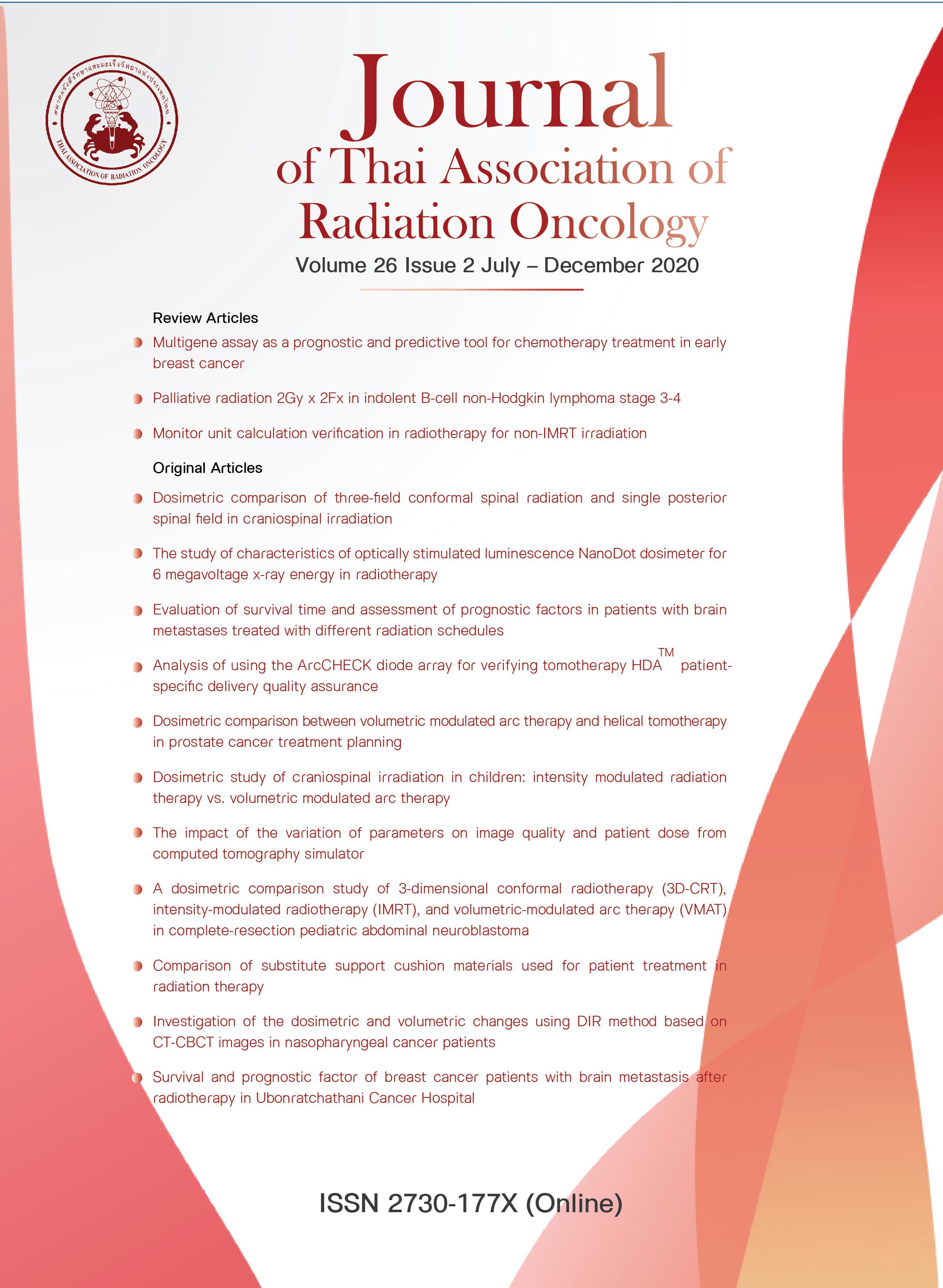Analysis of using the ArcCHECK Diode Array for Verifying Tomotherapy HDATM Patient-specific Delivery Quality Assurance
Keywords:
ArcCHECK, Patient-specific QA, TomotherapyAbstract
Background: The ArcCHECK cylindrical diode array, which is real time analysis and reusable tool, has been introduced as a patient QA device for Tomotherapy plan.
Objective: The aim of this study was to investigate the dosimetric characteristics of ArcCHECK for Tomotherapy including the clinical usage as a dose verification tool.
Materials and Methods: The dosimetric characteristics of the ArcCHECK in terms of short-term reproducibility, dose linearity, field size dependence, including sensitivity of cylindrical diode array to variation of the Tomotherapy planning parameters i.e., field width (FW) and pitch were investigated. The clinical tests were used on twenty prostate cancers. The measured dose distributions using ArcCHECK and dose measurement from EBT3 films were compared with dose calculation from Tomotherapy treatment planning. The results were evaluated following the gamma criteria of 3%/3mm. The clinical action level was established by given a higher percentage of gamma passing than (100-CL) while CL was [(100-mean) + 1.96σ].
Results: The sensitivity of diode showed linearity with dose delivery in the range from 5s to 300s (R2=1) and the variations of repeatedly measured in the short-term period was within ±1.52%. The field size dependence exhibited the same response as the ionization chamber (CC13) except for 1 cm field width; the diodes exhibited 14.81% over-response when compared with the CC13, which may result from volume averaging of the CC13. The influence of planning parameters on sensitivity of ArcCHECK showed no difference of gamma passing rate with higher passing rate than 97% for all various FW and pitch plans. For clinical plans, ArcCHECK measurements demonstrated in the similar trend of EBT3 films analysis with a moderate positive correlation (r=0.59). The clinical action level of our institution was found 97% when using ArcCHECK as a verification tool.
Conclusion: The detector achieves the efficient dosimetric characteristics and ArcCHECK response is independent of Tomotherapy planning parameters. The percent gamma passing for patient-specific QA evaluation shows moderate positive correlation with the film. The ArcCHECK system can be considered as a reliable and an effective QA tool for patient verification of the Tomotherapy.
References
Mackie, T.R., et al., Tomotherapy: A new concept for the delivery of dynamic conformal radiotherapy. Medical Physics, 1993. 20(6): p. 1709-1719.
Yue, Q., et al., Systematic Analysis of the ArcCheck Diode Arrays for Tomotherapy Delivery Verification. International Journal of Medical Physics, Clinical Engineering and Radiation Oncology, 2014. 3(04): p. 218.
Devic, S., N. Tomic, and D. Lewis, Reference radiochromic film dosimetry: review of technical aspects. Physica Medica, 2016. 32(4): p. 541-556.
Massillon-JL, G., et al., Energy dependence of the new Gafchromic EBT3 film: dose response curves for 50 kV, 6 and 15 MV x-ray beams. International Journal of Medical Physics, Clinical Engineering and Radiation Oncology, 2012. 1(02): p. 60.
Hussien, M., Evaluation of detector array technology for the verification of advanced intensity-modulated radiotherapy. 2015, University of Surrey.
Low, D.A., et al., Dosimetry tools and techniques for IMRT. Medical Physics, 2011. 38(3): p. 1313-1338.
Niroomand-Rad, A., et al., Radiochromic film dosimetry: Recommendations of AAPM Radiation Therapy Committee Task Group 55. Medical Physics, 1998. 25(11): p. 2093-2115.
Shimohigashi, Y., et al., Evaluation of a single-scan protocol for radiochromic film dosimetry. Journal of applied clinical medical physics, 2015. 16(2): p. 5226-5226.
Bladh-Johansson, C., Patient-specifc quality assurance for helical tomotherapy An evaluation of two different detector systems. 2010.
Myers, P., et al., Evaluation of PTW Seven29 for tomotherapy patient-specific quality assurance and comparison with ScandiDos Delta. Vol. 37. 2012. 72-80.
ArcCHECK datasheet. www.peo-radiation-technology.com.
ArcCHECK & 3DVH. Sun Nuclear Corporation:https://www.sunnuclear.com/documents/datasheets/arccheck3dvh.pdf.
Chaswal, V., et al., Commissioning and comprehensive evaluation of the ArcCHECK cylindrical diode array for VMAT pretreatment delivery QA. Journal of Applied Clinical Medical Physics, 2014. 15(4): p. 212-225.
Létourneau, D., et al., Novel dosimetric phantom for quality assurance of volumetric modulated arc therapy. Medical Physics, 2009. 36(5): p. 1813-1821.
Li, G., et al., Evaluation of the ArcCHECK QA system for IMRT and VMAT verification. Physica Medica, 2013. 29(3): p. 295-303.
Thiyagarajan, R., et al., Analyzing the performance of ArcCHECK diode array detector for VMAT plan. Reports of Practical Oncology and Radiotherapy, 2016. 21(1): p. 50-56.
Bresciani, S., et al., Tomotherapy treatment plan quality assurance: The impact of applied criteria on passing rate in gamma index method. Medical Physics, 2016. 40(12): p. 121711.
Thomas, S., et al., Reference dosimetry on TomoTherapy: An addendum to the 1990 UK MV dosimetry code of practice. Physics in medicine and biology, 2014. 59: p. 1339-1352.
Feygelman, V., et al., Evaluation of a new VMAT QA device, or the “X” and “O” array geometries. Journal of Applied Clinical Medical Physics, 2011. 12(2): p. 146-168.
Tas, B. and I.F. Durmus, Small field out-put factors comparison between ion chambers and diode dedectors for different photon energies. AIP Conference Proceedings, 2018. 1935(1): p. 170002.
Langen, K.M., et al., QA for helical tomotherapy: Report of the AAPM Task Group 148. Medical physics, 2010. 37(9): p. 4817-4853.
Evans, J.D., Straightforward statistics for the behavioral sciences. Straightforward statistics for the behavioral sciences. 1996, Belmont, CA, US: Thomson Brooks/Cole Publishing Co. xxii, 600-xxii, 600.
Downloads
Published
How to Cite
Issue
Section
License
บทความที่ได้รับการตีพิมพ์เป็นลิขสิทธิ์ของวารสารมะเร็งวิวัฒน์ ข้อความที่ปรากฏในบทความแต่ละเรื่องในวารสารวิชาการเล่มนี้เป็นความคิดเห็นส่วนตัวของผู้เขียนแต่ละท่านไม่เกี่ยวข้องกับ และบุคคลากรท่านอื่น ๆ ใน สมาคมฯ แต่อย่างใด ความรับผิดชอบองค์ประกอบทั้งหมดของบทความแต่ละเรื่องเป็นของผู้เขียนแต่ละท่าน หากมีความผิดพลาดใดๆ ผู้เขียนแต่ละท่านจะรับผิดชอบบทความของตนเองแต่ผู้เดียว




